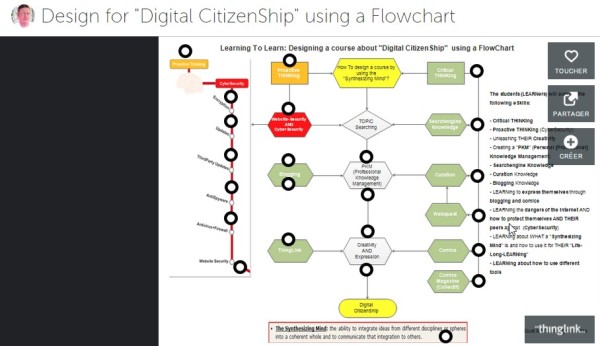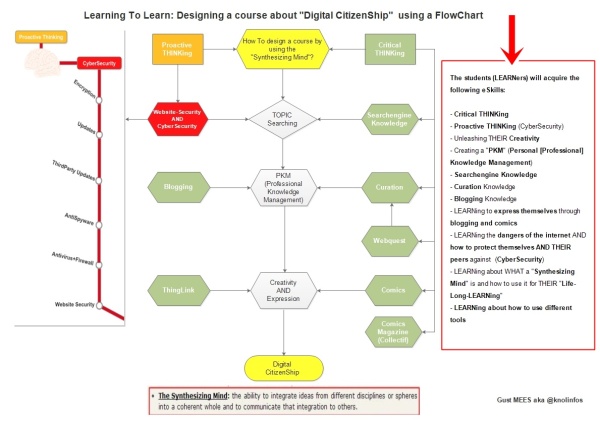
.
.
THE Reality
.
I hear most screaming ALREADY, WE are ONLY on EDUcation 1.0, or EDUcation 2.0 and starting to LEARN; EDUcation 3.0 is foreseen in the next years!!! Give us the time to LEARN!!! Well, WE are ALREADY on EDUcation 4.0, did YOU know THAT!? SO… it might be GOOD to START learning straight off NOW about EDUcation 4.0 as the LOWER versions (EDUcation 3.0) are ALREADY included, isn’t it!?
.
.
.
.
Some Reminders First!
.
The above mentioned quote from “Albert EINSTEIN” SHOULD get to be taught to Educators, Teachers, Instructors! We, as teaching persons should remember that one on any teaching lesson, this as well as in the classroom and especially when WE publish online (website, blog, Twitter posts…).
Learn more:
.
.
.
SO… WHAT’S EDUcation4.0?
.
SO… WHAT’S EDUcation4.0? OR at least WHAT SHOULD it be!? I advocate and I (try to) PUSH a transparent <===> #LEARNing and #LEARNingToLEARN through #PracTICE by #LEARNingByDoing <===> as students, learners need to first of ALL to know WHAT and WHY they need to learn that special topic. Transparency is a MUST in 21st Century: tell the learners, students THEIR <===> #LEARNingPath, it is their right to know it <===>, make it visual by designing the course so that they can see it and experiment around with it, they will learn EVEN before the course(s) start, which in my opinion is GOOD, just be prepared about that. As more they know about it before it even starts as better it is, be wise and calculate that to create groups where they exchange the already known with others who don’t know it yet; make THEM ALSO teachers who share THEIR knowledge. Let it GO, let it FLOW, make it a win-win situation. Let THEM take THEIR responsibility about LEARNing whereby YOU as teachers, educators, instructors are the coach WHO guides THEM through the <===> learning process<===.
Create a <===> ThingLink <===> LEARNingPath Design <===> where ALL your learning steps are included, e.g. <===> Design The Learning Of YOUR Learners, Students | Ideas <===.
Mention ALSO, probably the most important WHAT skills they will learn about AND WHAT is THE benefit for THEM!!! YOU will create a <===> success course(s) <===> isn’t that WHAT YOU WANT!?
Check below, please, to find an example of a designed course for <===> Digital CitiZENship <===
.

Click the above image, please, to access the article. Move YOUR mouse cursor over the image then, YOU will see “black spots” that are links to the course.
.
Learn more about design:
- Design The Learning Of YOUR Learners, Students | Ideas
- My curation about design
As YOU will probably have found out, it is about <===> PracTICE and student centered <===>! WHY!? Well, WE are living in the 21st Century and life has changed, the role of EDUcators and Teachers has changed ALSO! NOW it is the students, learner who will come MORE in the focus as the OLD known TEACHING is OUT, it is NOW about <===> TEACHINg about <===> LEARNing To LEARN <===> where the teaching persons act as a Coach who guide THEIR LEARNers to become independent <===> Life-Long LEARNers <===!
.
.
![]() Create a FAQ’s list together with the learners, students WHICH THEY decide about the FAQ’s. Give THEM a double task job; creating the FAQ’s AND let THEM make curation ALSO about it, and WHY NOT, let THEM create a <===> ThingLink <===> ALSO where THEY integrate THEIR LEARNing into it. AND if enough time and/or as creative homework let THEM create ALSO some comics (optional) about the <===> How-To <===> 😉 AND don’t forget please: ask THEM if there is something which THEY have seen what is in there interest and if possible learn about it and share it with THEM, so THEY will learn it and will be happy 😉
Create a FAQ’s list together with the learners, students WHICH THEY decide about the FAQ’s. Give THEM a double task job; creating the FAQ’s AND let THEM make curation ALSO about it, and WHY NOT, let THEM create a <===> ThingLink <===> ALSO where THEY integrate THEIR LEARNing into it. AND if enough time and/or as creative homework let THEM create ALSO some comics (optional) about the <===> How-To <===> 😉 AND don’t forget please: ask THEM if there is something which THEY have seen what is in there interest and if possible learn about it and share it with THEM, so THEY will learn it and will be happy 😉
Learn more:
- FAQ’s
- Curation
.
As most of YOU know me, I love to integrate sometimes videos, here we go.
.
.
Learn more:
-
Valuable Tools For The Learners (Students) AND Teachers (Educators, Instructors) For Preparation
-
LEARNing The Basics Of HTML To Use In Blogs | Creating FAQ’s
-
LEARNing To LEARN | Preparation For BETTER Learning | How To?
- My blogs about ThingLink
Together with @ICTPHMS WE have created some examples with ICT PracTICE, on a Global-Collaboration, please check below for inspiration:
- Learning To Become a GOOD Digital Citizen | Digital CitizenShip
- EDUcation-Collaboration And Coaching | The Future
- PracTICE: Learning To Learn-Digital CitizenShip
- …
- …
In preparation: FlowChart to create by Gust MEES
WHAT Are THE Skills Needed From Students In The Future!? OR, WHAT Are THE Jobs Look Like In The Future!?
That are actually questions which I get asked very often from people and where I could ask ONLY the first one! WHAT Are THE Skills Needed From Students In The Future!? Well, there is one well renown personWHO explains it BEST in my opinion, and that is Howard GARDNER. Please check the picture below to understand.
.
.
When YOU have a closer look than YOU will realize that the <===> Synthesizing Mind <===> is THE major skill needed! I use it since ages in my courses and with a big success! Actually ALL my blogs and blog posts are based on it.
.
.
Learn more from my NEW blog post below, please:
DO’S And DON’TS
WHEN YOU post on Social Media (Twitter, Facebook and…), please post so THAT everybody could understand it, YOUR messages, posts, blog posts, are getting ALSO read by an audience WHO is OUTSIDE the <===> #SchoolCocoon <===>! Check below, please as a GOOD reminder 😉
.
As YOU could see, I highlighted some, WHY!? Well, remembering WHAT was done WRONG during my study time, I MUST show these as they are STILL the ones WHO DON’T get respected by teaching persons!
Learn more:
[GM] Remind about WHAT is shown in my quote in the PIC, please 😉
.
.
Learn more:
Social Media DON’TS
 As the name says it already, it is about <===> SOCIAL <===>, so stay social, please. When using a “Twitter Chat” YOU are not alone, YOU will receive posts from OTHERS who are sharing stuff which could be of interest to YOU AND YOUR audience. YOU are NOT alone, DON’T forget this, please. YOU are, once connected to the internet, part of a global community. Everybody can take part in YOUR chat from around the globe, so posts (Tweets) will be visible in YOUR chats, that is called: Tweets in the stream.
As the name says it already, it is about <===> SOCIAL <===>, so stay social, please. When using a “Twitter Chat” YOU are not alone, YOU will receive posts from OTHERS who are sharing stuff which could be of interest to YOU AND YOUR audience. YOU are NOT alone, DON’T forget this, please. YOU are, once connected to the internet, part of a global community. Everybody can take part in YOUR chat from around the globe, so posts (Tweets) will be visible in YOUR chats, that is called: Tweets in the stream.
Visible Thinking: see it as if YOU read a Newspaper, YOU won’t read everything as not ALL of interest to YOU, do the same when reading the Tweets, read what is of interest, BUT DON’T block persons who are sharing, NOR “Mute” persons, that is NOT SOCIAL! Accept to be social and follow the above advice, if YOU can’t then it would be better to create a “Forum” where YOU could stay alone with ONLY the people you want to be together, BUT that is “Middle Ages” mentality 😉
Sounds hard!? If so, please check if YOU have a fixed mindset and/or how-to get a growth mindset, YOU want to adapt to 21st Century, isn’t it?:
Learn more about Twitter Chats:
Please check the video below, who explains WHAT Social Media is.
.
..
Social Media DO’S
Using “Social Media” Twitter is a great way for connecting educators, teachers and for sharing their practices. Through Tweets (posts are called so) they can connect together and build a <===> Personal [Professional] LEARNing Network <===> a PLN. Through this PLN, educators, teachers and students will amplify their knowledge, they can build themselves a <===> Personal [Professional] Knowledge Management <===>, a PKM.
Learn more:
- WHAT is a PLN?
- PKM – Personal [Professional] Knowledge Management
- [DK] Effective Social Media Practices
DO’S In Teaching OR Let Us Say BETTER Learning Through PracTICE
Learning By Doing is the 21st Century mantra…
.
.
[GM] My experience over 12 years (up from 2002), benefits which I encountered for students, learners: I prepared every time a visual for my learners to show THEM WHAT they will learn and how WE would learn this together, any station of the <===> Learning Path <===> got explained, so they knew at any moment WHERE they were in their <===> Learning Process <===. Thus meaning: I designed the course as shown above (with different tools [as facilitators] as possible today…). Already 12 years ago 😉
WHAT did the learners, students benefit and HOW were they feeling?
Students and learners, especially adults and seniors (Andragogy), prefer working actively <===> Learning By Doing, PracTICE <===> as THEY are NOT really friends of THEORY! SO they were feeling much more FREE as they could act on their own, experimenting around, making some mistakes and learning from them. They learned more quickly as a result, once the mistakes transformed into positive thinking by NO fear anymore to try out NEW things, they were using their gained knowledge at home to learn on their own for their own PracTICE. They have a <===> profit <===> for their private life, so they love it to learn that way as it is useful!
WHAT are the skills Educators, Teachers should learn to master and teach the students!?
Well, some say that this is very difficult to find out!? Actually it isn’t at all. Let me explain, please. The MOST IMPORTANT, as mentioned already above is to find WHAT could be of interest to the learners, students, the benefit for them for their private life as well as the skills the workforce needs! And in this case WHAT I propose to YOU will be benefit for both!
These skills are concerned about:
- Curation
- [GM] My curation
- [GM] Curation about Curation
- Image editing
- Video
- Blogging
- [GM] BEST Infographic about Blogging and Blogs
- Learning To Learn
- Creativity
- Critical Thinking
- Proactive Thinking
- FAQ’s
- Feedback
- [DK] Why Technology alone will NOT fix our schools.
.
Concerning feedback: ALL of my proposed courses (already in 2002-2003) had (A MUST) to be evaluated by its course participants, this through an online formular to evaluate THE quality of my courses! This was a rule which I brought in myself to guarantee a consistent quality in my courses. Here below (let me brag a bit) one (I have the permission of the person to publish it) feedback who is more worth than a diploma for me. The students, learners opinion is the mirror about WHAT WE have taught them! PS: the below mentioned document is framed and displayed in my private (at home) office, so that I can see it each day to remember me to maintain the same quality. If being once in doubt (yes, that happens also sometimes, nobody is perfect…) I have a look back again on it and it gives me the force to continue again…
.
.
The above text is in French, if YOU are NOT used to the language of Molière please check this App with whom YOU can translate, actually very useful when visiting other countries then yours 😉
Translation Apps:
A bit of the whole story about the above reference: When I started to give courses in 2002 about ICT and the use in EDUcation, there was NOTHING where I could have copied something, nor references! I had to start from scratch!!! At that time I spent +/- 30 hours for one (1) hour course giving!!! I was reading books to find out about pedagogy with ICT, here my list <===> 21st Century Learning and Teaching: Multilingual Books Recommendations <===>
SO ALSO, I didn’t know the person mentioned in above reference (too much occupied to give BEST possible course…), it is ONLY after the course when I was reading his evaluation that I asked him; he was a retired “Director of differentiated EDUcation” (just 3 months retired as far as I can remember) with a “Doctorat in EDUcation Sciences“, I was perplex at first moment, YOU can imagine; getting such a brilliant evaluation from someone with such a reputation and education. I am very grateful to him for that, it is STILL my <===> Leitfaden <===> for my daily tasks to keep up my professional way!
Learn more:
3 PDF merged together…
.
Check ALSO and especially the Finnish School Model:
.
Check ALSO, my recommendation, this article from Jackie GERSTEIN, please.
.
Please check ALSO the video below, a MUST watch!!!
.
.
.
Check also @ICTPHMS recommendation for Teacher’s Who Use Technology via ==> TeachThought (twitter).
Co-author and my Global-Collaboration colleague Dan KIRSCH from @ICTPHMS will tell YOU a bit more about his own experiences about ICT PracTICE and <==> LEARNing By Doing <===>, check below please.
[DK] Dan, Your experience with students in here, please, thanks.
- Student created videos ==> “How Technology Has Impacted Our Lives.”
- 8th Grade Students Ezine Articles
- Teaching Digital Citizenship through Comic Strips
.
.
NEW Ways For LEARNing Through Social Media-Possibilities
In preparation: <===> Customizing LEARNing, get #LEARNers AND parents interested into LEARNing: Storify of Tweets, use Marking App to localize read articles (Organization), learning through and with Twitter…
[DK] During a recent twitter chat came across this infographic “Top Ten Tech Tips For Teachers” (above) excellent resource on the DO’s for teaching in the 21st Century!! The image is credited to ==> Kasey Bell.
.
.
.
Check ALL YOUR links once posted on Social Media AND on YOUR blogs!
.
.
.
Keywords necessary for me to create this blog post (my preparation): blogs, longer texts allowed in blogs as said by EDU, creativity not used, media use in blogs NOT used, infographics about blogs usage and standards from professionals, Collaboration, Global Collaboration, coaching, autodidact self-driven learning, learning on own pace, designing courses, TEAM teaching, ===> I know <===, NO PracTICE experience, BUT I know :(((, NAIVETY, ONLY positive without showing the reverse of the medal, MakerED, Maker Spaces, Coding, RESPONSIBILITY, LITERACY, MEDIA LITERACY, DO’S and DON’TS, LESS THEORY BUT MORE PracTICE,
.
|
The author Gust MEES is ICT Course Instructor, ”Member of the Advisory Board” from “Luxembourg Safer Internet” (LuSI), BEESECURE, Official Partner (Consultant) from the Ministry of Education in Luxembourg, project “MySecureIT“, Official Partner from the Ministry of Commerce in Luxembourg, project “CASES” (Cyberworld Awareness and Security Enhancement Structure). |
..
|
. The author Dan KIRSCH teaches courses in Information/Communications & Technology (ICT) and Career/Technical Education (CTE) for students in grades 6-8 at Patrick Henry Middle School in South Dakota, USA. Students in his classes focus on Social Media, Educational Technology, and most importantly Digital Citizenship. Currently, I have the priviledge to be on my school districts ICT curriculum committee. We are rewriting and updating our ICT curriclulum in grades 6-8 for the 2015-2016 school year. . You can find me also on:
|
.
.
Stay tuned for next blog post(s) 😉
.






























5 responses to “DO’S And DONT’S | Adapting To 21st Century EDUcation”